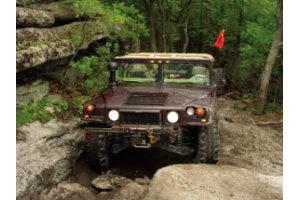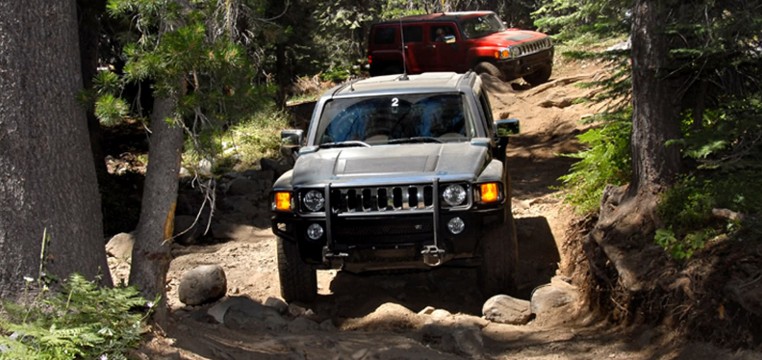By: Ultimate Hummers

Learning the ins and outs of proper off-road techniques.
Yes it’s true. A Hummer is one of the most capable off road vehicles out there. But that does not mean it is unstoppable. It does have its limits, and understanding these limits will help ensure that you, and your vehicle, make it back to the asphalt safely. There are several basic terms that you need to familiarize yourself with. You’ve probably seen terms in your owners’ manual, such as break over angles, side slope angles, fording depth, and just overlooked them. But these terms are what true off road enthusiasts look for to avoid the dangers off road such as rollover.
Basic training: know your clearance.
On the trails you will often hear people talk about choosing a “line.” This is a reference to the specific path that a driver chooses to travel within the bounds of the trail. What line you select will depend on a number of factors, the most crucial of which are the basic clearance limits of your vehicle. If you’ve ever taken your Hummer off-road, you probably discovered pretty quickly that it is not possible to see every part of the vehicle from the driver’s seat. What may have looked easy for the driver in front of you may suddenly seem a lot harder when the rock in front of you is no longer visible over your hood. If you want to get through a trail without banging up your truck too badly or getting stuck belly up on the top of a peak… then it is important that you understand the physical size and shape of your truck and what its limiting angles are.
Approach Angle
To understand what approach angle is, picture a line from the leading edge of the front tire, extending to the lowest point of the bumper, or to any other attachment that protrudes off the front of the vehicle (such as bulky bumpers, brush guards or winch fairleads.) This limit means the difference between climbing an obstacle and just plain running into it with your front bumper – if the slope exceeds the approach angle of your vehicle you will not be able to get a tire on it. You can maximize your approach angle by eliminating any unnecessary items that hang down or extend in front of the truck. Stock approach angles for Hummers are 72 degrees for the H1, 40.8 degrees for the H2, and 37.5 degrees for the H3.
Departure Angle
Departure Angle is the opposite of approach angle. Visualize a line from the lowest point of the rear bumper that also touches the rear edge of the tire. Obstacles that exceed this angle can cause the rear end to drag as the vehicle comes down off a slope. accessories such as spare tire carriers or Tow Hitch attachments can drastically reduce the departure angle capability of your vehicle, so keep that in mind when you are choosing how to outfit your vehicle for the trails. The H2 has a departure angle of 39.5 degrees, followed by the H1 at 37.5 degrees, and the H3 at 35.5 degrees.
Break Over Angle
The break over angle is a measure of the steepest angle the vehicle can negotiate without running the undercarriage into the obstacle. Break over is represented above by the yellow lines, forming a triangle with the apex in the middle, and the bottom corners touching each tire. Exceeding the break over limit of the truck will usually result it bottoming out, or worse yet the vehicle may get lodged at the top with no weight on the tires. That is how a vehicle can get “high-centered” – where all four Tires turn helplessly while the full weight of the truck remains perched on top of the obstacle. Break over specifications for a stock H1 is 29 degrees, 25.8 degrees for the H2, and 23.5 degrees for the H3.
Ground Clearance
Last but not least, just about everyone knows what ground clearance is – the height between the ground and the lowest hanging portion of the undercarriage, usually measured from somewhere under the middle of the vehicle. On a Hummer H1, very little hangs down on the truck to worry about, but in an H2 or H3, the straight axles have a housing in the middle that present a low hanging portion that the driver should be aware of; be sure to take into account your ground clearance if you have to straddle a rock or stump in the trail. If possible, drive a tire directly over the object instead of straddling it. Stock specifications from AM general and GM publish the stock ground clearance for the H1 at 16-inch, 9.7-inch for the H2, and 8.5-inch for the H3.
Don’t Forget The Corners
Remember, the clearances we have talked about are the basics, but they aren’t the only clearance issues to worry about – keep an eye on the height of your roof, and all of your corners as well; the front corners of the hood can be vulnerable when you are trying to turn in a tight space, and when you get the truck almost all the way past a tight squeeze, check those rear corners before you relax and speed away. Learn To Recognize The Size And Shape Of Obstacles
So, is it important to memorize these numbers? Absolutely not. Most rocks don’t come with labels that list height or the angles of their sides, so knowing the specifications really isn’t that important. What you should try to do is learn to judge the approximate size and shape of objects in the trail, and recognize how they compare to the capabilities of your vehicle. If you have doubts about your ability to clear an object, get out and take a closer look, and proceed with caution when you are confident that your vehicle will clear. Some drivers will even pull out a tape measure to check clearances on occasion – but a preferred method is to Observe the way other vehicles handle the obstacle, and to learn from your own experiences. If an H1 is in front of you and you are driving an H2, keep in mind that the limits are very different, so you may have to select a different line to get through the same portion of the trail. Eventually this kind of recognition will come easier and easier, and you will start choosing your lines based more on what looks like the most fun, rather than worrying about angles and limits all the time.
Stretching The Limits
I mentioned the stock specifications for the Hummer models during the overview of each limit, but there are some things you can do to physically alter those limits a little. One easy way to affect these physical limits is to install larger tires. If you put Tires on that are an inch taller than stock, the overall height of the vehicle will increase by _”, the leading edge of the tire will be _” closer to the front of the truck, and the trailing edge of the rear tire will be _” closer to the rear; these changes will affect every angle we have discussed. A suspension lift will produce beneficial results as well by raising the frame and bumpers of the vehicle higher off the ground, improving each of the angles described above as well. At the same time ground clearance increases, break over capability increases, and so does the departure angle. Body lifts do not offer as many benefits as a suspension lift, but it may allow you to install larger Tires – and all the benefits that go along with them. As is the case with any modifications to a stock vehicle, there are possible downsides to consider as well, like warranty issues and raising your center of gravity a tad – but for most wheelers the benefits outweigh the downsides. Besides physically modifying the vehicle, there are also some tricks that will allow a more experienced driver to push the maximum out of the truck when it comes to these limits. For example, break over angles can be exceeded sometimes, especially on “soft” ground… long as you don’t mind rubbing a little bit and carrying some momentum (but I will warn you, if you get high-centered learning how to do this, you will be amazed how stable a Hummer can be with all four Tires in the air!) When it comes to approach angle, you can sometimes get started on an obstacle that slightly exceeds your approach angle limitations if you cut the front Wheels hard to one side and get a tire on the object from the side. When an object in the trail is just a touch taller than your ground clearance you can try getting your Tires up onto higher ground; two Wheels up on the high side of the trail can effectively raise the ground clearance under parts of the truck by a couple of inches. Keep in mind that “not quite” clearing an obstacle can result in damage, getting stuck, and the accompanying ridicule from the others on the trail. So, proceed at your own risk and be smart about it. If you do get stuck while trying to push these limits… well, that is what the Hi-Lift jack, winch, and tow straps are for – but we’ll save that discussion for another time.
